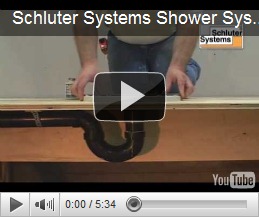OK, so what is all the fuss about getting a custom shower? It is a fair question, not without merits. A custom shower is an investment, and it is not one to be taken lightly. Did you know that in comparison to a rain forest, your shower receives more water on a yearly basis? In fact, the dishwasher in your home probably does not process as much water as your shower. Given these facts, ask yourself how much it is worth to ensure you have the right materials first and, not least importantly, the right technician second.
Have you ever seen an improperly assembled, custom shower? When you do, you will never forget it because behind the wall is a black, nasty mess. If you are on an upper floor, the first people to realize you have a leak will be the people below you, but if you live on the ground floor, you stand a good chance of never knowing it unless the mold starts infiltrating the inside of the shower or you decide to replace the existing tile.
You may wonder how anyone can install a leaky shower. The correct answer is that no one installs a leaky shower if they do it right! Properly installed, a moisture membrane prevents all water from penetrating the surrounding walls and touching the studs. The problem some tile mechanics have is that they never learned to properly prepare a shower for tile. Many installers continue to believe that the materials used in the shower are actually waterproof when in fact they are not.
Most installers believe that concrete board and backer boards are waterproof. This is an extreme misconception. The boards are designed to stay together in water and not fall apart, but they absolutely do not keep water from passing through it. There are a few water proof boards on the market. Georgia Pacific makes one call Denshield, and it actually has a moisture membrane on the front of the board. When you use the other boards though, you have to install a moisture barrier between the board and the studs. Many installers are ignorant of this fact.
Another tool for you to think about is a shower system. Shower systems are sold and marketed by certain companies to integrate with your tile in any set of circumstances. The two main ones that I know of are Schluter Systems and Wedi. Since our work involves Schluter extensively , I will spend my time talking about it.

The Schluter System comes with a preformed tray to place in the bottom of the shower. Since one of the hardest tasks for an installer is providing the proper gradient to the drain in order to prevent puddling, Schluter Systems rectified this with a pre-sloped pan. You would not believe the amount of people who overlook the necessity of a pre-slope underneath the normal shower pan. In fact, since it is not part of the building code in some parts of the country, it is not done at all most of the time. The pre-slope that I am talking about actually includes filling the place where the shower is located with a sloped bed of rocks or cement prior to the plumber’s installation of the rubber pan. The rubber pan actually sits on top of the bed, and once the pre-slope is installed, water actually will run down the face of the pan into the drain. Done without the pre-slope, the water will sit in the pan creating a moist donut shaped area around the drain where fungus and mold will love to hang out.
Once you install the tray, the Schluter kit comes with a special integrated bonding flange for the drain as well as a slip in drain that is square for ease of integration into the tile floor. Once the tray and flange are in place, the installer simply applies the Kerdi on the walls, floor, and curb to produce an orange looking shower before tile goes in. The key to the entire system is Kerdi which is an orange polyethylene film bonded to a layer of fleece on the front and back. The fleece provides a bonding surface to stick to the wall and to stick to the tile. The polyethylene layer provides 100% water tightness, even in an overlap situation. Schluter tested their system with a four to six inch overlap and documented no seepage; therefore, they do not require you to use entire sheets of Kerdi at one time. You simply seal it by overlapping the sheets a minimum of four inches.
that is square for ease of integration into the tile floor. Once the tray and flange are in place, the installer simply applies the Kerdi on the walls, floor, and curb to produce an orange looking shower before tile goes in. The key to the entire system is Kerdi which is an orange polyethylene film bonded to a layer of fleece on the front and back. The fleece provides a bonding surface to stick to the wall and to stick to the tile. The polyethylene layer provides 100% water tightness, even in an overlap situation. Schluter tested their system with a four to six inch overlap and documented no seepage; therefore, they do not require you to use entire sheets of Kerdi at one time. You simply seal it by overlapping the sheets a minimum of four inches.
Once the Kerdi is installed, the shower is ready for tile. Place the tile in position, install the drain, grout the tile, and you are ready to take a shower. The Schluter System really is the best on the market. For more information on Schluter Systems, visit www.CarpetOnePanamaCity.com or www.schlutersystems.com. Sign up for more information and to be on our mailing list.
You can buy these products at Carpet One Floor & Home which is an authorized reseller of Schluter Systems.
